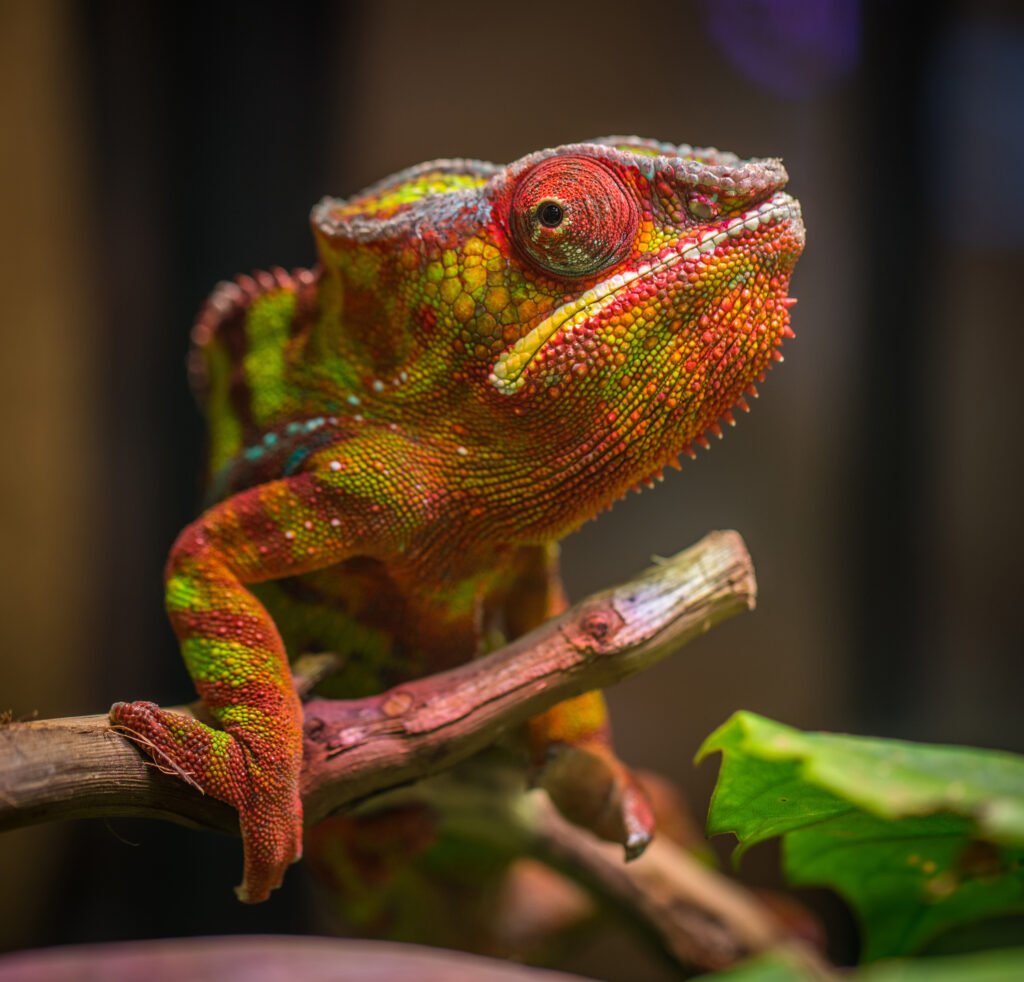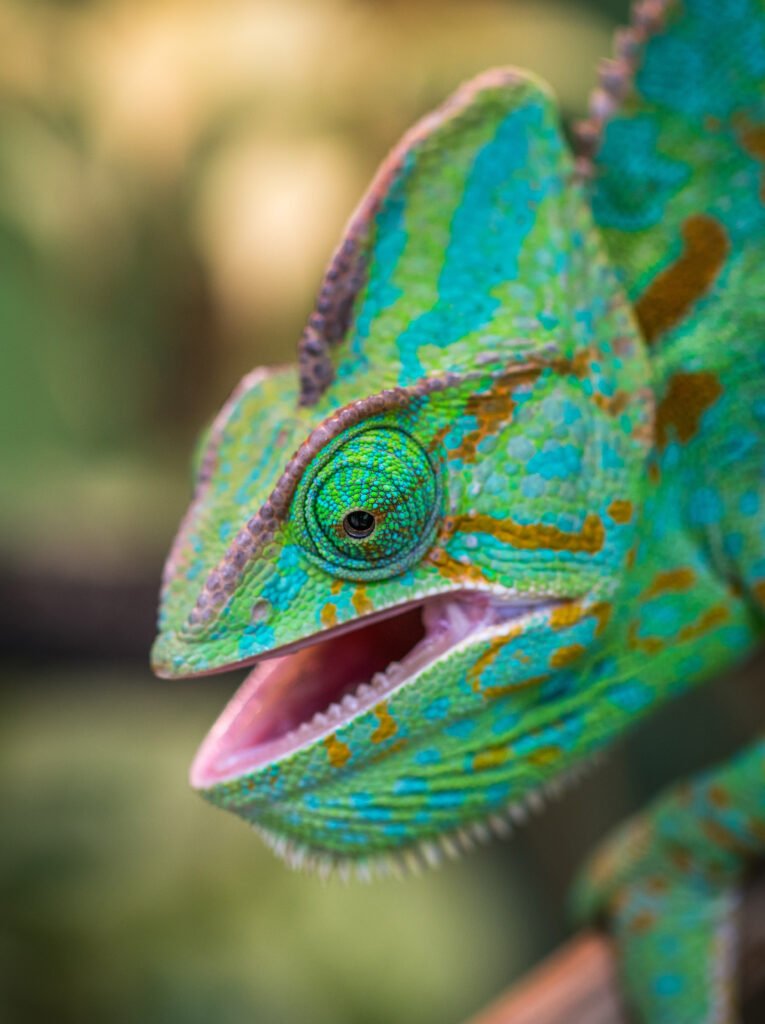What colours can a Chameleon change to?
Chameleon's can change their color to match their surroundings in order to camouflage themselves. The specific colors vary depending on the species, but generally, they can change into a range of colors including:
- Greens: Many are able to change into different shades of green, which helps them blend in with leaves and foliage.
- Browns: Some can change into different shades of brown, which helps them blend in with tree bark and other woody surfaces.
- Blues: Some species can change into a blue color, which helps them blend in with the sky and other bright surfaces.
- Yellows, oranges and reds: These colors are used as a way of communicating with other Chameleon's indicating their mood or territory.
- Black: Some species can change into a black color, which can help them absorb heat and stay warm or as a sign of stress.
Keep in mind that they can change their colors quickly and easily to match their environment or mood, and not all Chameleon's are capable of changing into the same colors.
Where Are Chameleon's From?
Chameleon's are found in various regions of the world, with the majority of species being native to Africa and Madagascar. Some species are also found in Asia, including parts of India, Sri Lanka, and southern China, and in Europe on the island of Madeira and the Azores. Some species are also found in tropical regions of the Americas and Oceania, but these are introduced species. In Africa and Madagascar, Chameleon's are found in a wide range of habitats, from rainforests to deserts, and can be found at elevations ranging from sea level to high mountain forests.
Most of them live in trees and shrubs, but some species live on the ground or in caves. They are arboreal lizards, meaning they spend most of their time in the trees, they have prehensile tails and grasping feet to assist in climbing. Their ability to change color allows them to blend in with their surroundings and avoid predators.
What Do Chameleon's Eat?
Chameleons are carnivores and their diet primarily consists of insects and other small invertebrates such as spiders, crickets, grasshoppers, and caterpillars. Some species of chameleons also eat small vertebrates, such as lizards and small birds. They use their long, protruding tongues to capture their prey, which they are able to shoot out at lightning-fast speeds to capture insects and other small animals.
Some larger species of chameleons, such as the panther chameleon, may also eat small mammals and reptiles. Some species of chameleons are also known to eat fruit and plants.
It's important to note that different species of chameleons have different diet requirements, so the diet of a chameleon will depend on the specific species. In captivity, chameleons should be fed a diet that is appropriate for their species, which can include a variety of live insects, fruit, and vegetables.
What Temperatures Do Chameleon's Live In?
Chameleon's are native to tropical and subtropical regions, so they are adapted to live in warm temperatures. The specific temperature range they can tolerate depends on the species, but in general, they prefer temperatures between 70 and 85 degrees Fahrenheit (21-29 degrees Celsius) during the day and around 10 degrees cooler at night. Some species such as the veiled chameleon, can tolerate temperatures as high as 90 degrees Fahrenheit (32 degrees Celsius) during the day, while others, such as the Panther prefer temperatures that are closer to 75 degrees Fahrenheit (24 degrees Celsius).
It's important to note that Chameleon's are cold-blooded, which means that they rely on external heat sources to regulate their body temperature. They are also sensitive to temperature changes, so it's important to provide a consistent and appropriate temperature range for them. In captivity, it's best to provide a basking spot with a heat lamp or ceramic heater to help them regulate their body temperature.
What Is The Biggest Chameleon?
The biggest Chameleon species is the Parson's Calumma parsonii) also known as the Giant chameleon. Native to Madagascar, and can grow up to 30-35 cm (12-14 inches) in length and weigh up to 0.7 kg (1.5 lb).
The Parson's Chameleon is a large and robust, it has a triangular head, long fingers and toes, and a long tail. The males are typically larger than the females and they have larger, more prominent casques (crests) on their head. They are usually green but can change color to brown and yellow, and they have a distinctive pattern of spots or ocelli on their skin.
In terms of other species, the Veiled Chameleon (Chamaeleo calyptratus) which is native to Yemen and Saudi Arabia, can grow up to 24 inches (61cm) long, and the Jackson's Chameleon (Trioceros jacksonii) from East Africa can grow up to 20 inches (51cm) long.
What Is The Smallest Chameleon?
The smallest Chameleon species is the Brookesia micra, a tiny species of chameleon that is native to Madagascar. It grows to a total length of just 29 mm (1.14 in) including the tail and it weighs less than 1.3 grams.
It has a brownish-gray coloration and its eyes are large in proportion to its body. It has a small size, it is one of the smallest reptiles in the world.
It's important to note that there are also other chameleon species that are considered small, such as the Pygmy chameleon (Rhampholeon viridis) and the Leaf chameleon (Brookesia tristis) which can grow to just a few centimeters in length.
How Many Toes Does A Chameleon Have?
Chameleons have four feet, each with five toes, two oriented in one direction and three in the opposite, they leverage this arrangement akin to a finger and thumb, enabling them to firmly grasp branches.
The Chameleon Tail
Similar to seahorses and monkeys, they adeptly coil their tails around branches, liberating their arms to extend towards the next perch while maintaining stability.
Unlike numerous lizard counterparts, Chameleon's lack the ability to regenerate their tails once lost.
Is A Chameleon A Reptile?
Yes, chameleons are reptiles. More specifically, chameleons are a type of lizard. They belong to the reptile class, which also includes snakes, crocodiles, and turtles.
Reptiles are cold-blooded animals that have scaly skin, lungs, and typically lay eggs. Chameleons have many characteristics that are typical of reptiles, such as scaly skin, a dry and scaly body, and they lay eggs instead of giving birth to live young.
Reptiles are also ectothermic, meaning they rely on external sources of heat to regulate their body temperature, which is why chameleons have to bask under the sun or a heat lamp to warm up. This characteristic is also known as being poikilothermic.
Chameleons also have a unique set of characteristics that are different from most other reptiles, such as their ability to change color and their grasping feet and prehensile tail that are adapted for climbing.
How Long Do Chameleon's Live For?
The lifespan of a chameleon varies depending on the species, but most chameleons have an average lifespan of around 5 to 10 years.
However, some species can live longer. For example, the panther chameleon (Furcifer pardalis) can live up to 12 years in captivity, while the veiled chameleon (Chamaeleo calyptratus) can live up to 8 years in captivity.
It's important to note that chameleons in captivity tend to live shorter lives than those in the wild, due to factors such as poor diet, lack of proper care, and disease. In order to ensure a long and healthy life for your chameleon, it's important to provide them with a proper diet, appropriate temperature and humidity levels, and a clean and spacious enclosure.
It's also worth noting that chameleons are considered to be a challenging pet to keep and care for, so it's important to do research and have a good understanding of their specific needs before committing to keeping one as a pet.
What / How Many Chameleon Species Are There?
There are over 180 different species of chameleons, which are divided into several different genera. Some of the most well-known and commonly kept chameleon species include:
- Veiled chameleon (Chamaeleo calyptratus)
- Panther chameleon (Furcifer pardalis)
- Jackson's chameleon (Trioceros jacksonii)
- Parson's chameleon (Calumma parsonii)
- Pygmy chameleon (Rhampholeon viridis)
- Leaf chameleon (Brookesia tristis)
- Nose-horned chameleon (Calumma nasutum)
- Oustalet's chameleon (Furcifer oustaleti)
- Flap-necked chameleon (Chamaeleo dilepis)
- False chameleon (Bradypodion)
These are just a few examples of the many different species of chameleons that are available. It's important to note that different species of chameleons have different needs in terms of diet, habitat, and care, so it's important to research the specific species you are interested in before committing to keeping one as a pet.
What Is The Rarest Chameleon?
There are many chameleon species that are considered rare, and the rarity of a species can be due to different reasons such as habitat loss, over-collection, or disease. The exact definition of rarity also varies, some species might be considered rare in the wild but common in captivity.
One of the rarest chameleon species is the Silhouette chameleon (Furcifer lateralis) which is found only in a small area on the island of Madagascar and it is considered critically endangered. Other species considered rare include:
- The Amber Mountain chameleon (Furcifer Campani)
- The Sambava chameleon (Furcifer lateralis)
- The Golden-crowned sifaka (Propithecus tattersalli)
- The Aye-aye (Daubentonia madagascariensis)
- The Bornean earless monitor (Lanthanotus borneensis)
These are just a few examples, but there are many other chameleon species that are considered rare or endangered. In addition to the threats mentioned above, illegal trade and habitat destruction are also major causes of the decline of many chameleon species. It's important to be aware of these issues when considering keeping a chameleon as a pet and to obtain them only from reputable breeders or rescue organizations.
Brookesia nofy Chameleon Discovery
Tourists have unexpectedly discovered a tiny new species of chameleon in Madagascar, an island situated off the southeast coast of Africa.
The species was found in a coastal patch of rainforest, a habitat that is highly endangered on the island.
Scientists have named this leaf chameleon Brookesia nofy. Amazingly, it's not even the smallest chameleon species! Brookesia nofy grows to around 33mm in length, while its close relative, Brookesia nana, is even smaller, measuring just 22mm to 29mm — roughly the size of a one-pound coin!
There are 13 other species of Brookesia leaf chameleons in the world, but due to habitat destruction in Madagascar, the species is already classified as Critically Endangered.























